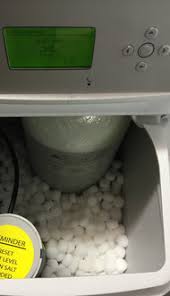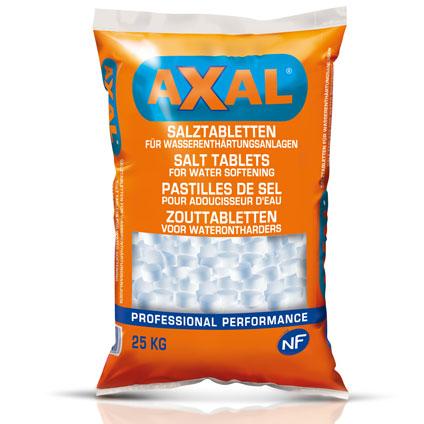SALT compressed pellet, for water softener device, bag 25kg
Valid Article
SALT compressed pellet, for water softener device, bag 25kg
Form
Compressed tablets of Salt (NaCl)
- Weight: 15 gram
- Diameter: 25mm
- Height: 16mm
- Packaged in plastic bag of 25 kg
Fit
The salt is only to be used with a water softener device.
A water softener is made up of three components: a control valve, a mineral tank, and a brine tank.
The tank is connected with the hose to the bucket of salt water (the size varies depending on the size of the installation). The salt pellets are placed in the brine tank. The bottom of the brine tank always contains a little bit of water. The salt dissolves in the water and forms a hypersaline brine solution.
Function
A water softener removes minerals that create water hardness, one of the most common water quality problems.
Water softeners work through a process called ion exchange which eliminates calcium and magnesium from the water. When the hard water enters into the mineral tank, it flows through a bed of spherical resin beads. These plastic beads, usually made from polystyrene, are charged with a sodium ion. The resin beads are anions, meaning they have a negative charge. The calcium and magnesium minerals have a positive charge, making them cations. Since opposite charges attract, the negative charge of the minerals is attracted to the positive charge of the resin beads. As the hard water passes through the resin, the beads grab ahold of the mineral ions and remove them from the water. When the bead seizes the mineral ion, the sodium ion is released. The column of resin strips all the hardness out of the water as it passes through the mineral tank, and softened water flows out.
The salt for the water softener enables and activates the resine in the resine tank of the water softener. The brine solution will be let into the resine tank. This will ensure that the resine in the tank is activated and saturated with Na plus ions. Now if the city water (input water) with a high degree of hardness (Calcium Carbonate CaCO3) will pass through the resine in the resine tank all the Ca ions will remain in the resin and will be replaced by Na ions in the water that will be used by the end user. By removing the Ca plus ions in the water by Na plus ions, there will be now hard residue in water conducts after some time and if water is boiled in a pan in the kitchen there will be no white deposit in the cooking pan. For MSF this device is needed to protect sensitive equipment that works with heat and vapour in sterilization rooms.








